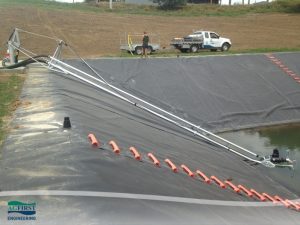Pond/Tank Stirring

Pond and Tank Stirring
Efficient Pond and Tank stirring/agitation is important to ensure that solids remain in solution, for either pumping to solid separation or to land application.
Effective pond or tank stirring will prevent solid build up on the surface and solids precipitation. This ensures that all solids either remain in solution or are broken down, forcing them back in the solution for pump removal in a homogeneous state at all times.
The hydraulic action of the stirrer is critical to ensure that the required agitation motion and velocity is achieved. A large number of stirrers are being installed, which have varying degrees of effectiveness.
Why is it important to choose the correct stirrer?
It important to choose the correct stirrer to ensure
- That solids are agitated with sufficient energy to either keep item in solution, or break them down so they are forced back into solution.
- That the lifetime cost (Capital + Operating) is understood with the different options. Operating costs are 50% - 80% of the lifetime cost. Investing in an efficient stirring solution will result in significant operating cost savings which can range from a $10,000 - $20,000 saving over 15 years. Consider propeller power consumption vs flow rate (m3/hr per kW). Efficiency is achieved by propeller design, motor design/cooling and energy loss between the motor and the propeller, propeller cavitation, long shafts, bushes, bearings, gearboxes, pulleys and air cooled vs. liquid cooled motors. Manufacturers of efficient stirrers will be able to provide this information.
- That the most effective and practical stirring system is installed calculated by tank/pond dimensions, volume and quality of effluent.
- That the effluent has a uniform consistency to achieve uniform nutrient application to land at all times (as the pond/tank liquid level changes) and to prevent sudden infrastructure blockage and wear (pump, pipeline, irrigator).
- Stirrer positioning and ease of adjustment from the shore. Stirrers thrust direction should be altered periodically as solids can build up in lower velocity zones (areas in the pond/tank where liquid travel speed is less due to stirrer thrust direction).
- Horizontal mounting will achieve the greatest velocity as energy and momentum is lost when thrusting towards the floor of the pond or tank.
Customisation of stirrer systems
It is important that the stirring system installed is customised.
Key considerations:
- Consideration of pond and tank dimensions.
- Consideration of liquid specific gravity (dry matter density) and solid particle size distribution of the effluent that requires to be kept in suspension.
- Any seasonal variations in effluent.
- Available power supply.
- Pond or tank lining protection.
- Pond or tank liquid level. This relates to propeller cavitation and expected level of anaerobic activity (ponds/tanks with greater depths).
- Fixation of the stirrer and motor protection to withstand unbalance due to foreign matter or large masses.














